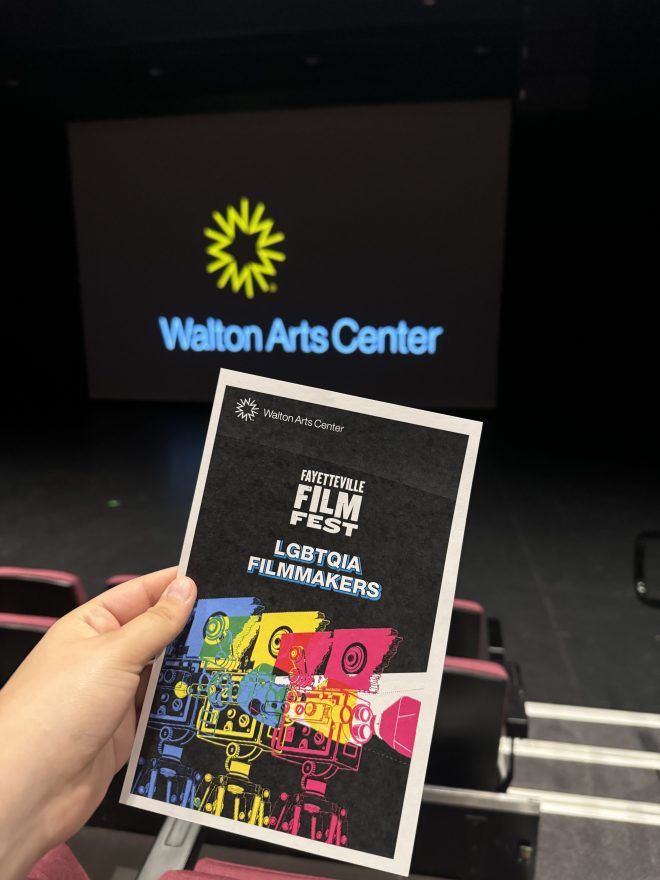Fayetteville Film Fest showcases queer stories for Pride Month

Fayetteville Film Fest hosted a night to highlight LGBTQ+ short films shown in the Starr Theater at the Walton Arts Center.
The “LGBTQIA Filmmakers” event showed five films, ranging from eight minutes to 22 minutes, with a variety of topics at the center of their work that related to the queer experience.
The first film “Crush” was directed by Hunter R. Adams. The film depicts the awkward situations that can occur with reconnecting with an old friend as a teenager, and adds an especially hard layer of navigating transitioning in between the distance.
The two main characters come across some transphobic comments and while the cis one claims that her friends are just being “stupid,” her old friend sets her straight. She learns that she needs to put distance between those who are transphobic if she wants to reconnect with her old friend.
“The Bag” was the only film spoken in another language other than English. It opened with a shot of Muhammad, a transgender woman from Iran, hanging up photos of her family while having a conversation on the phone with her mom.
Suddenly, Muhammad stops conversing in her tracks once her mother brings up the doctor her father had shared her situation with. From the audience perspective, it can be inferred the topic at hand could be related to her gender identity.
A central component to the film is the bag, the title’s sake of the film, seems to encapsulate the aspects of her identity she has to keep hidden. She claims to have only bought dresses for someone else’s use, then later a scene plays of her dancing in a red dress that she can’t even zip all the way.
The scene of her dancing was both beautiful, but immensely sad as the viewer could see the joy that could not be shared with the world.
“O Family” was the first film to not center around the trans experience in the program. It focused on Jill and her attempts to come out to her family as aromantic asexual. Arriving at the Christmas celebration, it is clear there is some tension between her and the family, such as when she spills wine ruining her Christmas sweater and her discomfort at the dinner table learning her brother and his partner got a house.
The discomfort develops even further as the announcement of her brother’s engagement sends assumptions of her future spouse her way. When she shares with the family that she is uninterested in a relationship, there is backlash of erasure that there is someone she just has to wait for.
She even goes to make the comparison that she should be accepted for her asexual identity, just as her brother was for being gay, but he claims that this is nothing like that. The film showcases not only the issues that come from family, but the ways in which the queer community is not always an ally to each other.
The next film shown was “Sacrament” and surrounded the new arrival of a gay couple’s daughter. At the midst of the pandemic, the two bring her to meet family and come to have a public disagreement about the baptism of the baby.
Throughout the film, one husband argues for waiting to let her decide to be baptized herself when she is old enough while the other ultimately sides with his family, as it is tradition to get their children baptized wearing a white baby bonnet. Paired with the events of January 6 playing out in real time, the audience learns that the nonreligious partner has trauma regarding his old church and the tortures of conversion therapy.
The film ends abruptly, with the religious husband in the church with the baby in the bonnet and you never know for sure if he goes through with the baptism for his family or stops for his partner.
Although there were some technical difficulties that made the audience unsure if that was truly the ending, after a brief intermission, the final film “Jim’s Tips” began.
Directed by Piper Peña Hadley, the film opens up with a set of homemade videos left behind by Jim for his future child on how to be a man. As the audience follows along learning how to tie a tie, the viewer finds out that the child is a transgender teen Flora.
She chooses to wear the tie that her dad used in the video, getting ready for the prom in a suit. The screen pans to a funeral pamphlet, revealing the death of Jim. The film ends with Flora back at home after prom, watching the final Jim’s Tips home video where she is mouthing along to the monologue of her father who unfortunately never got to see the true her.
Overall, the film selections touched on many unique joys and struggles that queer people face. The diverse stories and actors brought a variety of color to the screen making the collection well represented.





Comments